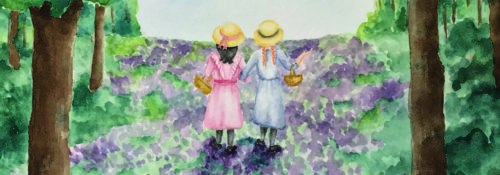
So Much Scope for Imagination: The Vivid World of Anne of Green Gables
Written by Monica VanDerWeide, ’95
For more than a century, Anne Shirley, Prince Edward Island’s spirited redhead, has delighted readers with her boundless imagination and endless escapades. From a hair-coloring experiment gone bad to an afternoon tea featuring liniment-flavored cake, the beguiling “Anne with an ‘e’” offers laugh-out-loud entertainment to adults and children alike. But underneath the humor that runs throughout the book are themes that contribute to Anne’s transformation from an unwanted orphan to the pride and joy of the village of Avonlea. Lecturer in History Dedra Birzer suggests discussing the following themes and topics with students as they read Anne of Green Gables.
Imagination—We learn early on that Anne has an imagination that never quits; furthermore, she gets frustrated by people and situations with “no scope for imagination.” “Anne’s imagination is what allows her to survive prior to coming to Green Gables,” Birzer says. Indeed, in the first two paragraphs of Anne’s dialogue, she mentions “imagination” eight times as she describes other children at the orphanage and what she would have done if Matthew Cuthbert had not come to pick her up at the train station (“…it would be lovely to sleep in a wild cherry tree…don’t you think? You could imagine you were dwelling in marble halls, couldn’t you?”). Later in the book, Anne helps her friends cultivate their imaginations through a story club, coaxing stories out of them. “I mostly always have to tell them what to write about, but that isn’t hard for I’ve millions of ideas,” Anne tells Marilla Cuthbert.
Beauty—Anne notices the beauty of the landscape and seasons that many of the townspeople take for granted. She names features of the land—Mr. Barry’s pond is the Lake of Shining Waters—and she gives the roads to school fanciful names like Lover’s Lane, Willowmere, Violet Vale, and the Birch Path. In doing so, Anne “puts down roots and attaches herself to these places,” Birzer says. Anne’s sense of wonder about the beauty of nature, coupled with her imagination, brings a new awareness of beauty to the residents of Avonlea. “Through her imagination, Anne opens up the villagers to seeing the world around her,” Birzer adds.
Orphans—Birzer suggests that teachers talk to students about how the perception of an orphan has changed in the last 100 years. “At the time of this book’s publication, an orphan was brought into a family with the expectation of working for that family,” Birzer says. The Cuthberts wanted a boy to help Matthew work on the farm. However, shortly after bringing Anne home, Matthew puts aside the notion of an orphan as a farm hand. He recognizes the value of having Anne as a companion and considers her a part of the family.
Mistakes—While Anne finds herself constantly stumbling into scrapes and gaffes—often a result of her wild imagination—she feels contrition afterward and strives to improve herself. As she tells Marilla two years after her arrival, “Ever since I came to Green Gables I’ve been making mistakes, and each mistake has helped to cure me of some great shortcoming….I feel quite sure that you will soon see a great improvement in me.” “Ask your students what they learn from their mistakes,” Birzer suggests. “How do you balance imagination with reality?”
Love—At the beginning of the story, a forlorn Anne declares, “Nobody ever did want me.” Yet we see that Matthew is smitten with Anne almost immediately. As the story unfolds, we see Anne find love among the townspeople—her “bosom friend” Diana; the town busybody, Mrs. Lynde; the harsh-turned-soft Aunt Josephine; and the dashing Gilbert Blythe (although Anne won’t own up to it for years). But perhaps the greatest example of transformational love is the relationship between Anne and Marilla. At the end of the book, the stern spinster finally admits to Anne: “I love you as dear as if you were my own flesh and blood and you’ve been my joy and comfort ever since you came to Green Gables.” “Anne is a gift to the Cuthberts and the whole town,” Birzer says. “She gives them so much.”
Download a (PDF format) Anne of Green Gables poster for your classroom.